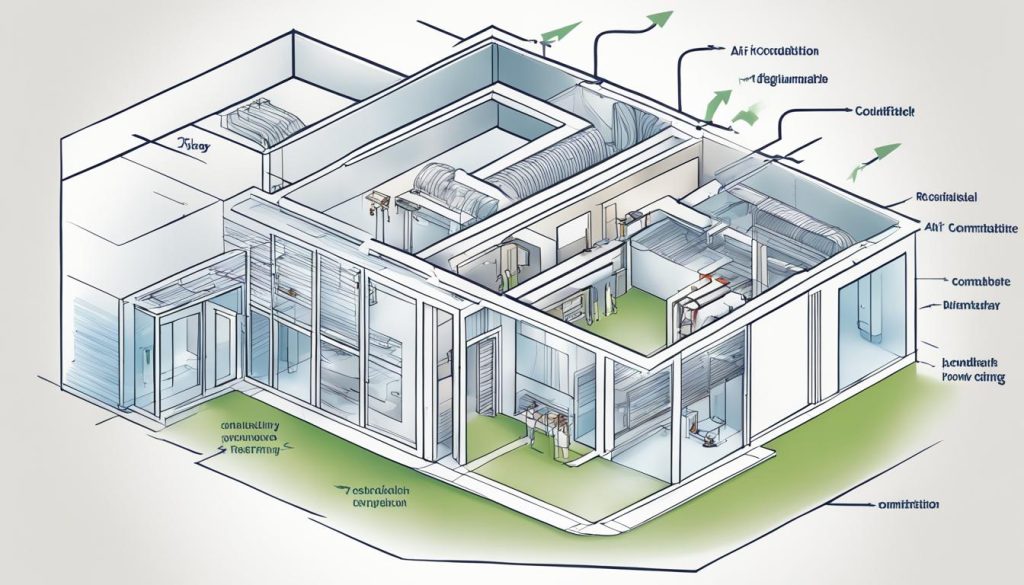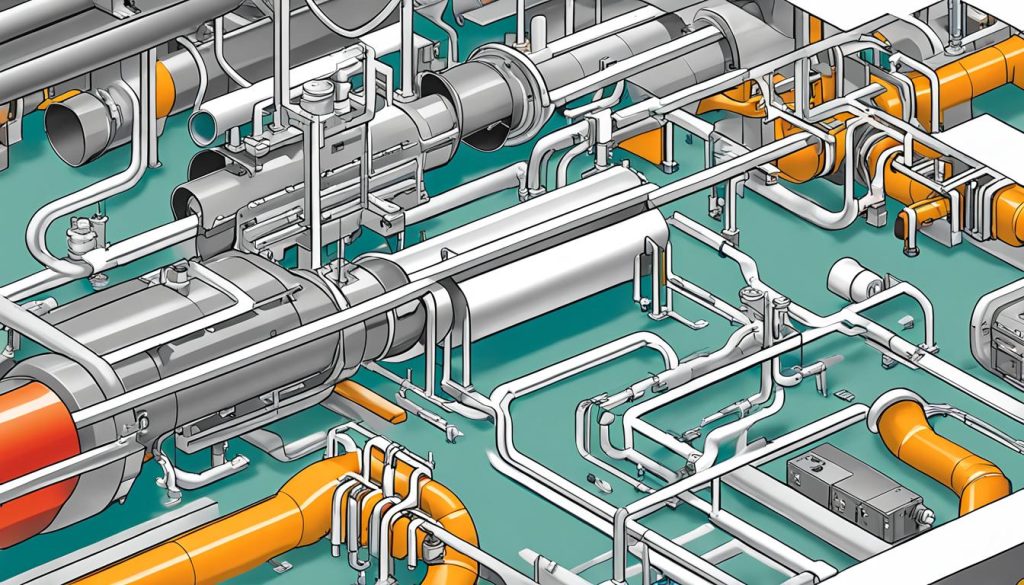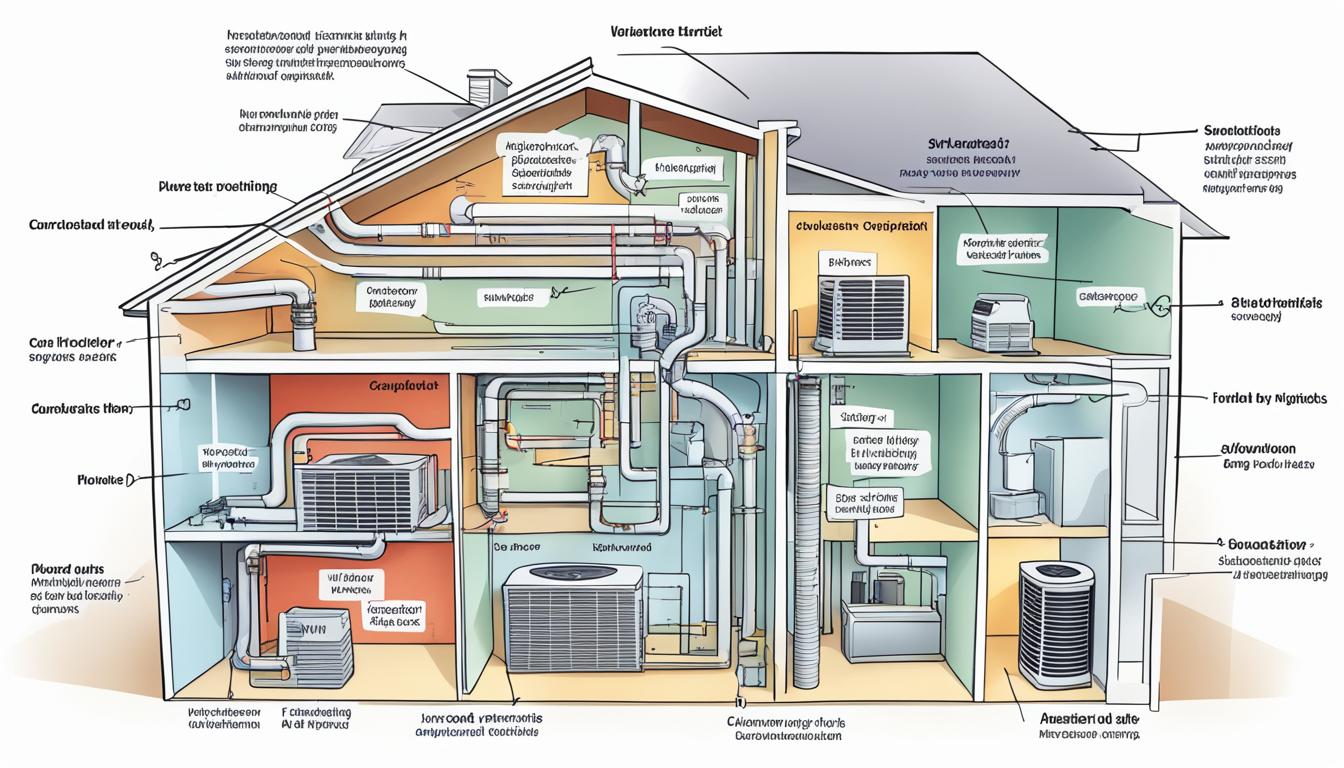Ensuring your ductwork is the right size can help you save on energy costs. Well-designed ducts are key to your HVAC system’s efficiency. They make sure air flows evenly and cut down on energy waste. By focusing on ductwork design, you’ll see better comfort in your home and lower utility bills.
Good duct systems balance airflow and save energy. This means planning the duct layout, picking the right sizes, and using the correct materials. Doing this makes your HVAC system more efficient, improves air quality, and saves money over time for homeowners.
Understanding the Importance of Proper Ductwork Design
Proper HVAC duct design is key to a comfy and efficient home. You might not often think about ductwork, but it’s vital for your heating and cooling system. Let’s see why well-designed ducts are crucial for your home’s comfort and saving energy.
The Role of Ductwork in HVAC Efficiency
Your ductwork is like your home’s circulatory system. It spreads conditioned air around your living areas. If ducts are the right size, your HVAC system works better. This means lower energy bills and a more comfy home for you.
Impact on Indoor Comfort and Air Quality
Rightly designed ducts make sure your home stays at a steady temperature. No more hot or cold spots! They also help keep the air clean. Good ductwork filters and moves air well, cutting down on allergens and pollutants.
Long-term Cost Implications of Ductwork Design
Investing in quality ductwork design can save you money over time. Here’s how:
| Aspect | Impact on Costs |
|---|---|
| Energy Efficiency | Lower monthly utility bills |
| System Longevity | Reduced repair and replacement costs |
| Maintenance Needs | Fewer service calls and cleanings |
| Indoor Air Quality | Potential health savings from cleaner air |
By focusing on proper ductwork design, you’re not just making your home more comfy. You’re also investing in long-term energy savings and cost savings. Remember, well-designed ducts are essential for a top-notch HVAC system and a healthier home.
Principles of Effective Ductwork Sizing
Getting your ductwork sized right is key for a top-notch HVAC system. You must think about several important factors when planning your duct layout. Let’s dive into the main principles that help with efficient airflow and save energy.
First, figure out your HVAC load needs. This means looking at the heating and cooling each room requires. Consider room size, insulation, and where windows are placed. These details help you pick the right duct sizes.
Then, work on airflow calculations. Figure out how much air your system needs to keep things comfy. This helps you pick the correct duct sizes to avoid blockages and ensure air moves smoothly.
| Factor | Impact on Ductwork Sizing |
|---|---|
| Room Size | Larger rooms need bigger ducts |
| Building Layout | Changes duct routing and length |
| Insulation Quality | Changes heating/cooling load |
| Window Placement | Changes heat gain/loss calculations |
When designing your ductwork, go for smooth bends and transitions. Sharp turns can block airflow and cut efficiency. Use strategies for even air distribution to prevent hot or cold spots in your building.
Right duct sizing stops system strain and boosts energy efficiency. By sticking to these principles, you’ll get a ductwork system that makes your space more comfortable and cuts down on costs.
Common Issues with Poorly Sized Ductwork
Poorly sized ductwork can cause many problems with your HVAC system. These problems can make you uncomfortable and also waste energy. Let’s look at some common ductwork issues and their effects.
Restricted Airflow and Its Consequences
Small ductwork limits airflow in your home. This makes your HVAC system work too hard. It becomes less efficient and uses more energy. You might feel weak airflow from vents or find some rooms hard to heat or cool.
Energy Waste Due to Leaks and Poor Insulation
Leaks and bad insulation in ducts waste a lot of energy. When air leaks out, your system runs longer to make up for it. This raises your energy bills and shortens your system’s life.
Uneven Temperature Distribution in Buildings
Ductwork problems often cause uneven temperatures in your home. Some areas might be too hot, while others are cold. This not only makes you uncomfortable but also shows your HVAC system is struggling.
| Ductwork Problem | Consequence | Impact on Efficiency |
|---|---|---|
| Undersized ducts | Restricted airflow | Increased energy consumption |
| Leaky ductwork | Air loss in unconditioned spaces | Higher utility bills |
| Poor insulation | Temperature fluctuations | Reduced system performance |
| Improper duct design | Uneven heating and cooling | Increased wear on HVAC components |
Fixing these ductwork issues is key to better HVAC efficiency and saving energy. It also helps even out temperatures in your home. By improving your ductwork, you’ll be more comfortable, save money on energy, and make your HVAC system last longer.
Optimize Airflow to Reduce Energy Costs with Ductwork
Improving airflow through your ductwork can greatly reduce energy costs. Efficient ductwork is vital for better HVAC performance and a cozy indoor space. Let’s look at ways to optimize airflow for energy savings.

Sealing ducts is key to stopping air leaks. Use mastic sealant or metal-backed tape to make sure the air stays where it should. This simple step can increase your system’s efficiency by up to 20%.
Adding insulation to your ducts helps keep the air at the right temperature. It’s especially important in areas like attics or crawl spaces. This keeps the air at the desired temperature as it moves through the system, easing the load on your HVAC unit.
Ensuring your ducts are the right size is also crucial. Correctly sized ducts spread the air evenly, keeping temperatures consistent across your building. This stops hot and cold spots, making your space more comfortable.
| Optimization Strategy | Benefits | Potential Energy Savings |
|---|---|---|
| Duct Sealing | Prevents air leaks | Up to 20% |
| Duct Insulation | Reduces heat transfer | 10-15% |
| Proper Duct Sizing | Improves air distribution | 5-10% |
| Duct Placement in Conditioned Spaces | Minimizes energy loss | 15-20% |
Putting ducts in conditioned spaces helps cut down on energy loss. This method reduces the temperature difference between the duct air and the environment. It leads to better efficiency.
Regular maintenance is crucial for your system’s best performance. Clean registers and make sure nothing blocks the airflow. By following these tips, you’ll have an energy-efficient ductwork system that saves money and boosts comfort.
Tools and Techniques for Ductwork Sizing Calculations
Getting ductwork sizing right is key for efficient HVAC systems. Let’s look at the tools and methods pros use for the best airflow and energy use.
Manual D Calculations: A Professional Approach
Manual D calculations are the core of professional duct sizing. They consider things like friction rate, static pressure, and airflow needs. This way, HVAC experts can make duct systems that save energy and meet standards.
Software Solutions for Ductwork Design
Ductwork design software has changed the game. These tools do precise modeling for fast and correct sizing. They have 3D visuals and update automatically, making design quicker and less prone to mistakes.
| Feature | Manual D Calculations | Ductwork Design Software |
|---|---|---|
| Accuracy | High | Very High |
| Speed | Moderate | Fast |
| Visualization | Limited | 3D Modeling |
| Updates | Manual | Automatic |
Considering Static Pressure in Sizing Calculations
Static pressure is crucial for good airflow. By including static pressure, pros can make systems work well under different conditions. This avoids problems like blocked airflow and uneven temperatures.
With these tools and methods, you can make ductwork that boosts comfort and cuts energy costs. Whether you choose Manual D or the latest software, focusing on the right size means better HVAC performance.
Materials and Components for Efficient Ductwork Systems
Choosing the right duct materials and energy-efficient components is key to a top-notch HVAC system. Your ductwork is crucial for spreading conditioned air in your home or building. Let’s look at the best options for an efficient ductwork system.

Sheet metal ducts are a top pick for their strength and seal tightness. They keep their shape, cutting down on air loss. Fiberglass ducts are great for insulation, saving energy and lowering noise. Flexible ducts are perfect for small spaces or where you need to bend the duct.
Insulation is key for saving energy. Fiberglass is a budget-friendly choice that works well. Foam insulation has a high R-value and fights moisture. Reflective insulation keeps heat out in hot places, making your system more efficient.
| Duct Material | Advantages | Best Application |
|---|---|---|
| Sheet Metal | Durable, leak-resistant | Main trunk lines |
| Fiberglass | Insulating, noise-reducing | Residential systems |
| Flexible | Adaptable, easy to install | Tight spaces, short runs |
Components like dampers, registers, and grilles help control airflow. Dampers let you change airflow to different parts of your building. Registers and grilles direct air into rooms. Picking the right mix of these parts means better system performance and comfort.
By picking the right duct materials, insulation, and efficient components, you can make a ductwork system that saves energy and cuts costs. Talk to an HVAC pro to find the best options for your space and needs.
Installation Best Practices for Optimal Airflow
Getting your ducts installed right is key for great airflow and saving energy. Focus on sealing, insulating, and balancing to boost your system’s performance and cut energy bills.
Proper Sealing Techniques to Prevent Leaks
Sealing your ducts well is crucial for keeping air in and energy costs down. Use mastic sealant or metal-backed tape on joints and seams. Don’t go for cloth-backed duct tape as it doesn’t last long. Make sure to check and seal connections between ducts and vents well, as they often leak.
Insulation Strategies for Energy Conservation
Insulating your ducts helps keep heat from escaping or entering unwanted areas. Wrap them with fiberglass insulation or foam board. Make sure the insulation is tight and covers all the duct surface for best results.
Balancing Airflow Throughout the System
For even temperatures, balance your ductwork’s airflow. Adjust dampers, size ducts right, and ensure enough return air. Experts use special tools to fine-tune airflow for the best performance.
Follow these best practices to make your HVAC system more efficient, comfortable, and cost-effective. While some tasks are DIY-friendly, complex ductwork jobs are best left to professionals.
Maintenance and Upgrades for Existing Ductwork
Keeping your duct system in good shape is crucial for a smooth-running HVAC. Regular check-ups can catch problems early, saving you money later. Start by looking for leaks and making sure all vents are clear. This keeps air flowing well in your home.
Energy-efficient upgrades can make old ductwork work better. Sealing leaks and adding insulation are easy ways to improve performance. If your system is old, think about resizing ducts to fit your current needs. These changes can lead to lower energy bills.
HVAC optimization is more than just regular upkeep. For older homes, moving ducts to conditioned areas can make a big difference. It’s best to hire experts who can check your system and recommend the best changes. Their knowledge ensures your ductwork works well, making your home more comfortable and saving you money.
Regular maintenance and smart upgrades are good for your home’s comfort and efficiency. Taking care of your ductwork means a more comfortable home and lower energy bills. Remember, a well-kept system is a happy system!





0 Comments